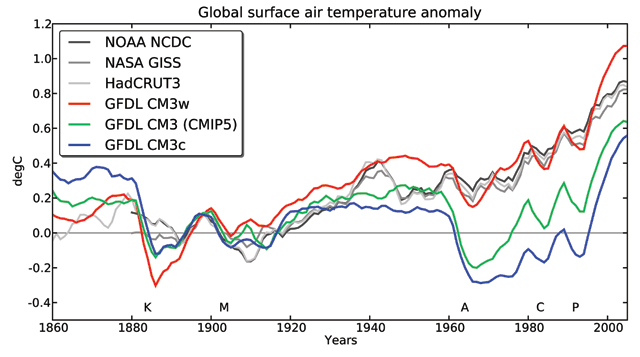March 4th, 2013
Key Findings
- Climate models incorporate a number of adjustable parameters in their cloud formulations that arise from uncertainties in cloud processes. The choices for these parameters are not unique.
- Starting with the GFDL CM3 coupled climate model, we construct two alternate, yet plausible, configurations (CM3w, CM3c) by modifying uncertain cloud parameters.
- For each alternate configuration, we perform coupled integrations over the historical period 1860-2005.
- The present-day climate (1981-2000) is nearly indistinguishable between all configurations.
- However, the magnitude of the aerosol indirect effects varies substantially from one configuration to another.
- As a result, the degree of warming over the 20th century is very different (figure below) is the warmest configuration and compares the best with observations.
Jean-Christophe Golaz, Larry W. Horowitz, Hiram Levy II. Journal: Geophysical Research Letters. DOI:10.1002/grl.50232
Summary
Clouds remain one of the largest sources of uncertainty in predictions from climate models. Globally, clouds cool the Earth through the net effect of two opposing contributions: cooling from reflection of incoming solar radiation and warming from trapping of infrared radiation emitted by the Earth. By comparison, the cooling effect of clouds is estimated to be about six times larger than the warming effect resulting from the increase in anthropogenic greenhouse gases since 1750. This is why uncertainties in the representation of clouds can have considerable impact on the simulated climate.
In addition to greenhouse gases, anthropogenic activities have also led to an increase in emissions of aerosols. Aerosols can alter cloud properties by making clouds more reflective as well as increasing their lifetime. These effects are known collectively as “aerosol indirect effects”. They tend to cool the planet, potentially offsetting a portion of the warming from greenhouse gases. The exact magnitude of this cooling is, however, uncertain.
Climate models incorporate a number of adjustable parameters in their cloud formulations that arise from uncertainties in cloud processes. These parameters are tuned to achieve a desired radiation balance and to best reproduce the observed climate. CM3 is the first GFDL coupled climate model to represent aerosol indirect effects. As in other models, the representation in CM3 is fraught with uncertainties.
We investigate the impact of uncertainties in cloud tuning in CM3 coupled climate by constructing two alternate configurations (CM3w, CM3c). They achieve the observed radiation balance using different, but plausible, combinations of parameters. The present-day climate is nearly indistinguishable among all configurations. However, the magnitude of the indirect effects differs by as much as 1.2 Wm−2 , resulting in significantly different temperature evolution over the 20th century (Figure below). CM3 predicts a warming of 0.22 °C. CM3w, with weaker indirect effects, warms by 0.57 °C, whereas CM3c, with stronger indirect effects, shows essentially no warming. CM3w is closest to the observed warming (0.53-0.59 °C).



